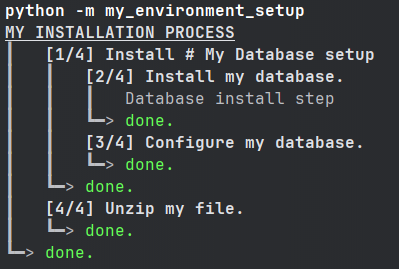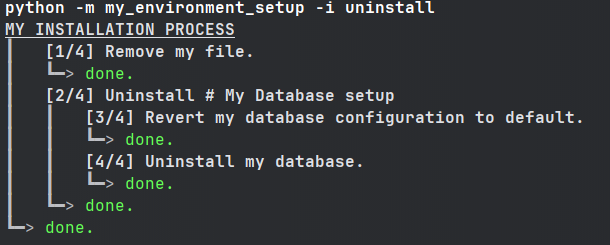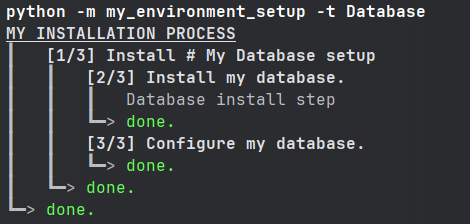A simple library to help you define your installation process, in Python !
Project description
Install process
For a better experience, check the docs: https://install-process.readthedocs.io/en/latest/index.html
A library to help you define your installation processes.
What is install_process ?
This library's goal is to help you create an installation process for any kind of application / environment.
With install_process, you can define your entire installation process as a couple of small "install-steps",
which are then executed one after the other.
When defining your install-steps, install_process also handles what needs to be done when you need to
uninstall/reinstall part or the entirety of your install-process.
This lib can be compared to tools like ANSIBLE, but for much simpler and local scopes (while still being easily callable with ANSIBLE if finally your project grows big enough).
This lib has no dependencies to be easily installed on computers without internet access.
This is an effort to replace old Windows/Linux scripts with Python scripts (check here for more details). It is tested on Linux/Windows (not tested on Mac — though it should probably work just fine).
Install
pip install install_process
Quick-start
Case
Let's suppose you need to set up your environment, and for that you need to:
- install an SQL database
- configure the database
- unzip a file at a certain location
You could use install_process to define:
- The database installation & uninstallation process
- the database install & uninstall
- the database configuration & revert to default config
- Unzip the file & remove the file
The code
Here's how you could do this using install_process:
# file: my_environment_setup.py
from install_process import InstallStep, InstallSteps, InstallProcess, setup_install
class InstallMyDatabase(InstallStep): # The database installation & uninstallation process
def install(self) -> None:
"""Install my database.""" # This docstring will actually be displayed during the installation process
# do what's required to install your database here
# you can display messages to users if you want
self.display.msg('Database install step')
# you can call shell commands such as ``self.shell('install mysql')``
def uninstall(self) -> None:
"""Uninstall my database.""" # This docstring will actually be displayed during the uninstallation process
# do what's required to uninstall your database here
class ConfigureMyDatabase(InstallStep): # The database configuration & revert to default process
def install(self) -> None:
"""Configure my database."""
# do what's required to configure your database here
def uninstall(self) -> None:
"""Revert my database configuration to default."""
# do what's required to revert configuration here
class Database(InstallSteps): # Let's regroup database-install & database-config under a same step (optional)
"""My Database setup""" # This docstring will actually be displayed
steps = [
InstallMyDatabase(),
ConfigureMyDatabase(),
]
class UnzipMyFile(InstallStep): # Unzip the file & remove the file
def install(self) -> None:
"""Unzip my file."""
# unzip your file where required here
def uninstall(self) -> None:
"""Remove my file."""
# remove your file here
class SetupMyEnvironment(InstallProcess): # Put everything together
"""MY INSTALLATION PROCESS""" # This docstring will actually be displayed
steps = [
Database(), # Database install & config
UnzipMyFile(), # File unzipping
]
if __name__ == '__main__':
setup_install(SetupMyEnvironment)
Launch install, uninstall, reinstall
Now you can install your entire environment:
python -m my_environment_setup
Uninstall your entire environment, using the -i option:
python -m my_environment_setup -i uninstall
Uninstall then install the entire environment:
python -m my_environment_setup -i reinstall
Re-install only a specific part
If you wish to only install/uninstall/reinstall a specific part of your environment, you can do so by providing the name of the step you want to install/uninstall/reinstall.
To get the name of all steps (this does not install or uninstall anything):
python -m my_environment_setup -n
Then you can call only a subset of your installation process:
python -m my_environment_setup -t Database
python -m my_environment_setup -t Database.ConfigureMyDatabase -i reinstall
Project details
Release history Release notifications | RSS feed
Download files
Download the file for your platform. If you're not sure which to choose, learn more about installing packages.
Source Distribution
Built Distribution
File details
Details for the file install_process-1.0.post0.tar.gz.
File metadata
- Download URL: install_process-1.0.post0.tar.gz
- Upload date:
- Size: 382.3 kB
- Tags: Source
- Uploaded using Trusted Publishing? No
- Uploaded via: twine/5.1.1 CPython/3.12.2
File hashes
| Algorithm | Hash digest | |
|---|---|---|
| SHA256 |
6dde116fa68cc640185412d9cd969b3a15f55accd473d4fac5301a88a0f86eef
|
|
| MD5 |
75ca55554d082c1c76e3c75ad8096d7a
|
|
| BLAKE2b-256 |
70a70d33baa660ce19d9ff42736cd37a483a4639ed18fc356291e2f055ca6788
|
File details
Details for the file install_process-1.0.post0-py3-none-any.whl.
File metadata
- Download URL: install_process-1.0.post0-py3-none-any.whl
- Upload date:
- Size: 9.7 kB
- Tags: Python 3
- Uploaded using Trusted Publishing? No
- Uploaded via: twine/5.1.1 CPython/3.12.2
File hashes
| Algorithm | Hash digest | |
|---|---|---|
| SHA256 |
d75e2721ea98721efcb4971e7bc4a5f4d2924289c3ee88a67d647c6c2221407b
|
|
| MD5 |
7f69ab0d0cb672c7f14f5c76e1965549
|
|
| BLAKE2b-256 |
a84c114902e0036e168c0bac04bfd172a30aeefd2675da711087ac280f572abe
|















